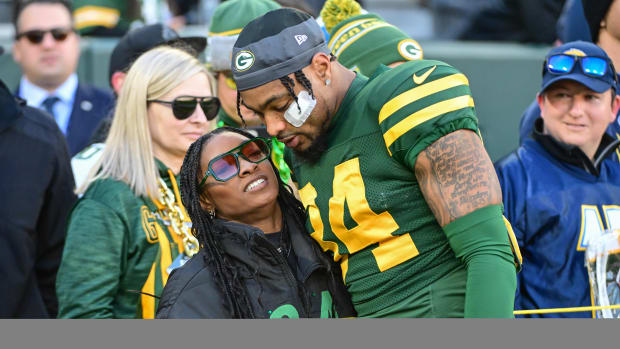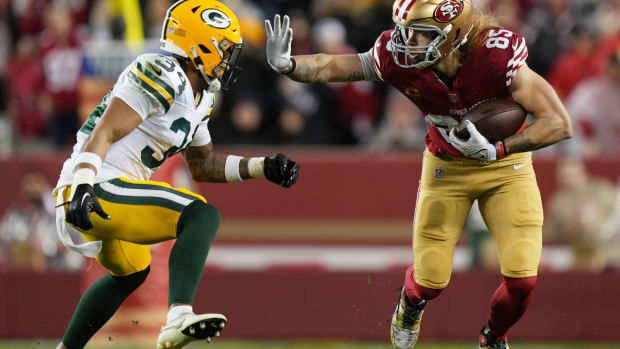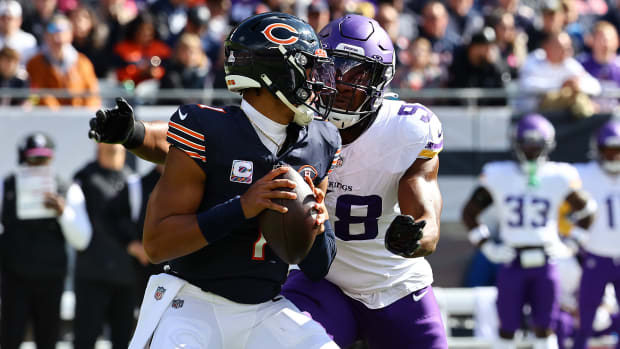Making Justin Fields Better Despite Limitations
With so many holes on the Bears roster and so few chances to fill them in the draft, not to mention their more frugal use of cash in this year's free agency, one thing has become apparent for at least this season.
Beyond the obvious possibility it could be a difficult first year for coach Matt Eberflus is that it's going to be all on Justin Fields to elevate this team. He's not going to get premium free agent receiver help to do it.
The Bears quarterback will be called on to carry the offense. Fields, Darnell Mooney and David Montgomery will need to be at their best each week for this rebuilding team to have a chance, but particularly Fields.
The natural progression for Fields in Year 2 would be playing better as a passer because he knows the offense and because he can read defenses better. Well, one of those is out the window already since it's a different offense and the other one is an unknown quantity. It's yet to be determined by Fields himself.
Still, there are ways Fields can become a more effective quarterback that have nothing to do with better surrounding talent, experience, reading defenses or being a better pocket passer.
It doesn't all have to be on Fields. The Bears can give Fields a better chance for success this season even if the personnel situation will be difficult until their 2023 year or salary cap spending freedom.
Here's how they do it.
1. Make Better Use of His Running
Particularly in the red zone, Fields can have a much bigger impact on games with his legs if he gets help. This was wasted last year, for the most part.
This isn't all on Fields' natural ability to react to pressure and scramble. Some of it involves coaching.
Matt Nagy and Bill Lazor last year showed almost no ability to use Fields the athlete. When they did, it looked forced, awkward and usually failed miserably.
The first attempt at this worked beautifully, a 3-yard TD run around left end against the Rams in the season opener to put the Bears within 20-14 in a game they lost 34-14.
It was only a gadget play because Andy Dalton was still the quarterback and Fields came in just for the moment near the goal line. After that, creative use of Fields' running ability vanished in the red zone.
Fields ran the ball nine times from the opposing 20 and in, and he came away with one touchdown there. It happened on the very first run he ever made. He only had two rushing TDs on the year, the other being the spectacular athletic move on a scramble against the 49ers. The Bears used him on only three non-scrambles inside the red zone and none of these were quarterback draw plays. They all involved a run around end of some sort.
Considering offensive line coach Chris Morgan worked as an assistant with Washington when it had RG III and also worked for Seattle during its Super Bowl win in 2014 with Russell Wilson, it's likely he'll have a better idea how to get blockers to better help a mobile passer who can run.
Offensive coordinator Luke Getsy has been with an offense operated by Aaron Rodgers his entire NFL career so he knows something about mobility in the passing game and how it can relate to quarterbacks running.
The offense can be designed to help one of the league's most mobile passers take advantage of his legs in addition to his arm.
They might want to look, too, at the fact he had the highest yardage per pass attempt among rookie quarterbacks on play-action, but according to Sportradar he was only allowed to throw play-action passes 48 times by Matt Nagy and staff.
2. Scramble Drills Again and Again
Fields is a quarterback who should be able to burn defenses outside the pocket if he is in sync with receivers more on broken plays. Bears receivers struggled last year at finding open spots in coverage after Fields broke the pocket, even Allen Robinson. They looked like a group of basketball players standing around while the flash point guard drove to the basket. All it takes is some movement.
Getsy comes from an offense where this was ingrained in all his receivers.
Eberflus was quoted by The Athletic's Adam Jahns as wanting to see more of these types of plays from Fields when he breaks containment.
"He's dangerous because now we want to be able to look down the field and strike people that way rather than running—that will make him extremely dangerous," Eberflus said in the article.
This is one way a team with a group of receivers who won't be among the league's best can be more effective. They just become more adept at finding open spots after their routes have been run so a scrambling Fields can find them.
They dabbled at this and talked about it some last year but didn't make a commitment to this the way the Packers do with Rodgers. Fortunately, they do seem serious about this. Byron Pringle even made mention of being good at this skill when he arrived from Kansas City. Equanimeous St. Brown should be familar with it after coming from Green Bay.
3. Improved Pass Blocking
With the way the offensive line isn't coming together personnel-wise—losing the chance at Ryan Bates was a big blow—it still shouldn't take much to improve the pass blocking Fields has over last year's. Considering Fields was sacked 36 times, Bears quarterbacks were sacked the most in the league (58 times) and that Fields was under duress a league high 42.5% of throws according to Pro Football Focus, it shouldn't be hard for the Bears to give him a better chance.
There are some who believe Fields brings this on himself by holding the ball too long and there is some truth to this, but much of the reason he held the ball too long is he needed to give receivers more time to get open because they were going downfield more. Fields had the fourth-highest rate of passes thrown 10 to 19 yards (24%) and the third-highest percentage of throws 20 yards or longer (16%), so naturally he had the ball longer. He does still need to get rid of the ball faster and this also will be on coaches and Fields to work at more. But the thought he is holding the ball too long indecisively is an exaggeration.
Either way, any amount of better pass blocking should be of benefit.
4. Better Faking
There is no real metric to support this, only the eye test.
Like most rookie quarterbacks, Fields was mediocre to poor at handling the ball. He has an offensive coordinator who worked with the league's real master at faking. Kirk Cousins worked with current Bears quarterbacks coach Andrew Janocko at it and improved at this in a bootleg-heavy attack, as well. It should begin to show in Fields' game. Even Fields' fake handoffs in RPOs or bootlegs need improvement and Getsy's background is a help in both categories when they work with him at this.
Better faking comes with confidence in the rest of the game. The more success Fields has, the more adept at this he can become.
5. Taking Care of the Football
Remember, taking care of the football is the third principle of Matt Eberflus' HITS approach. At least on the offensive side it is. On defense, the "T" stands for taking it away. They're going to do everything possible to get Fields to avoid turnovers. This doesn't just mean interceptions, which would be more on Fields than anything else.
Fields fumbled more times (12) than he threw interceptions (10) last season. His 12 fumbles tied for fourth most in the NFL. While they lost only five, a fumble is potential disaster because they turned it over on five and when he lost it they immediately lost chances to gain yards on the other seven.
Getting Fields to be more aware of the rush is part of the solution, but some goes back to his throwing motion.
Remember the quote from NBC's Chris Sims, the one that earned him a lot of critcism from Bears fans?
"There's a hitch in his giddyup there and he tries to create fake force with that, which leads to a slower release and him just not letting it rip out there," Sims said.
The hitch is his awkward looking arm motion displayed when he has the ball pointing down toward the ground exposed. While it does somewhat lead to slower release time, the bigger danger is how it exposes the football to pass rushers. It's sitting out there hanging on a hook simply waiting to be taken for a split second.
The more they can coach this practice out of him, the fewer fumble risks taken.
It's not like Fields uses this motion on every throw. This was apparent from his first rookie camp practice. He'd make some throws perfectly without relying on his crutch. But in games when he's under pressure or on downs when he really needs to get zip on the ball in a hurry, he reverts back to this.
Ending it, or at least limiting it more, is a matter of repetition and establishing better practices with the help of coaches.





